Leather is a popular material used for crafting, clothing, furniture, and more. But when it comes to repairs or upcycling projects, many people have the same question – does hot glue work on leather?
The answer isn’t as straightforward as you might think. Hot glue can be an effective solution for certain types of leather repairs and projects, but it does have its limitations. In this article, we’ll explore the pros and cons of using hot glue on leather and provide some useful tips to help you make an informed decision.
Does a hot glue gun work on leather?
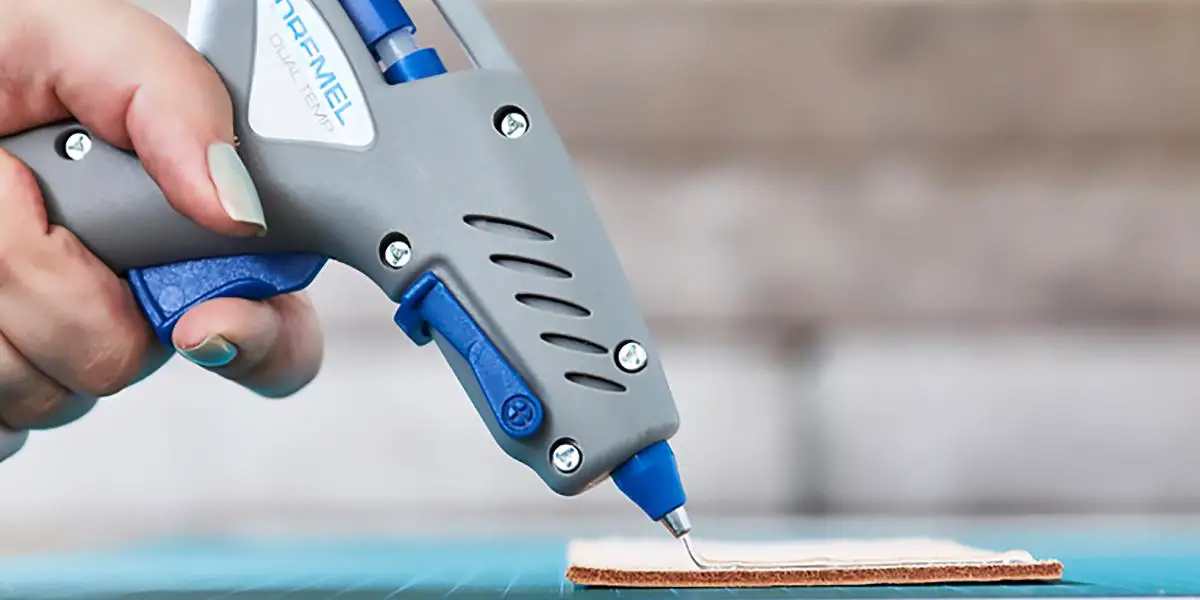
The short answer is yes, a hot glue gun can work on leather. Hot glue works best for small repairs and projects that don’t require strong hold or durability. It isn’t recommended for larger projects or items that will be worn or used frequently.
For best results, test the hot glue on scraps of leather before you begin your project. This will help you get a better idea of how the glue adheres and if it’s suitable for your application.[2]
Does heat melt leather?
Heat can cause the leather to shrink, stiffen, or become brittle. Properly applied heat will not melt the leather but it will cause a change in the texture. Heat may also damage finishes and dyes used on leather items. To avoid any damage to your leather items, use caution when using any type of heat source.[2]
Does hot glue stick to leather?
The short answer to this question is yes, hot glue does work on leather. However, it’s important to use the right kind of glue and apply it correctly for the best results.
Using a high-temperature hot glue gun with adhesive specifically designed for leatherworking is your best bet for securing pieces of leather together. Hot glue bonds quickly to leather, and it won’t damage or discolor the material.
However, if you use a lower-temperature glue gun, the glue will not bond as well and could come off with time. You should also avoid using regular craft glue as this can leave stains on leather that are difficult to remove.[2]
What materials can I use hot glue together with leather?
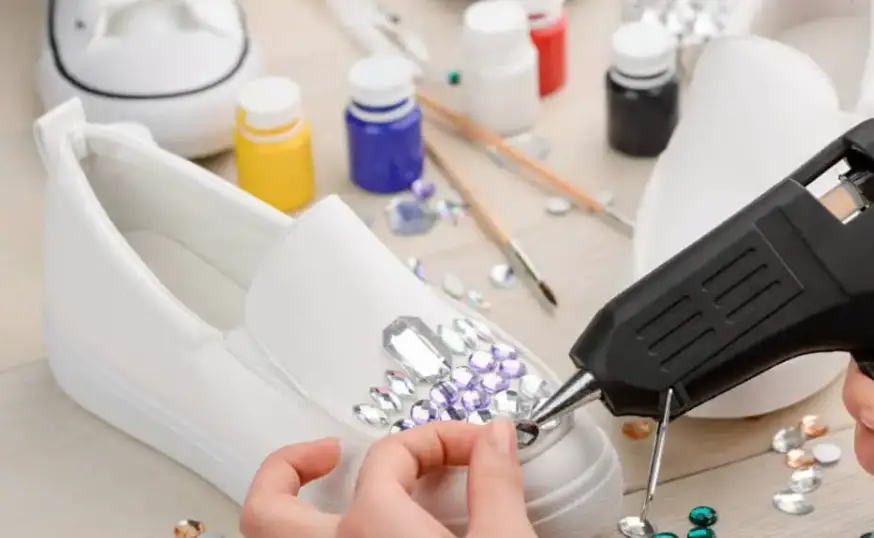
Can you hot glue fabric to leather?
When it comes to hot glue and leather, you may be wondering what materials can be used together. The answer is that you can use hot glue with a variety of different materials, including fabric and other non-leather items. For example, if you are creating a project that involves attaching fabric trim to your leather item, then hot glue would be an ideal choice.
When it comes to hot gluing fabric to leather, the answer is yes! The adhesive bond between the two materials will be strong and hold well over time. However, it’s important to note that you must use an appropriate glue for this application.[3]
Can you hot glue leather to leather?
Yes, you can use hot glue to adhere leather to leather. This is a great option for projects where you need a strong bond between two pieces of leather. However, it’s important to note that the bond will be strongest when done with an appropriate adhesive. Additionally, if you plan on using this method for a specific project, make sure to practice on scrap materials first to get a feel for the strength of the bond.[3]
Can I use a hot glue gun on faux leather?
Yes, you can use a hot glue gun on faux leather. However, it’s important to note that the bond won’t be as strong as when using an appropriate adhesive intended specifically for faux leather. Additionally, keep in mind that the temperature of the glue gun should not exceed the melting point of the faux leather material.[3]
How to use hot glue gun on leather
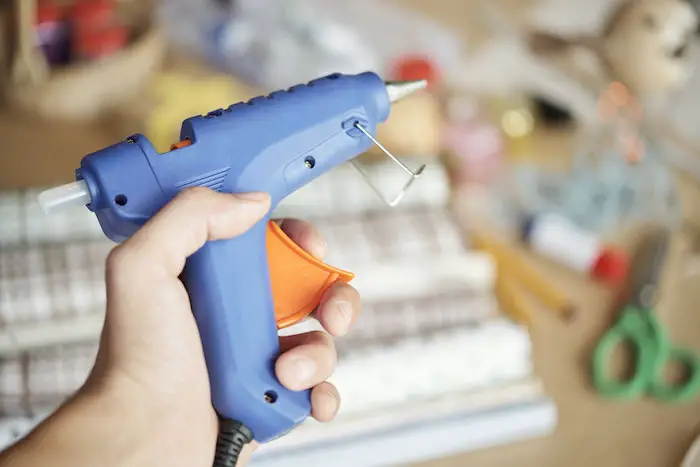
For faux leather
Faux leather is actually a plastic material, so it’s quite easy to work with. Before you start gluing any project together, make sure the surfaces are clean and free of dirt or debris.
Start by heating up your hot glue gun and adding a generous amount of glue to the backside of each piece that needs to be joined together. Firmly press the pieces together and hold for at least 30 seconds. It’s a good idea to have something heavy such as a book or brick, on top of the glued piece while it cools down.
The great thing about using hot glue on faux leather is that you don’t necessarily need to use any other fasteners such as screws or nails.[1]
For real and genuine leather
Real and genuine leather is a more delicate material to work with, so it’s important to use the right type of glue. Hot glue is not suitable for this job as it won’t provide enough flexibility or strength when the piece is moved around.
The best choice here is contact cement. This type of adhesive forms an instant bond between two surfaces that are held together firmly and can be flexed without coming apart.
Simply brush an even layer of contact cement onto the back of each piece to be joined, spread it evenly with a foam brush, then wait for about 10 minutes before pressing them together. Hold firmly in place for at least 30 seconds before releasing.[1]
Suede and nubuck
Suede and nubuck are even more delicate than real leather, so it’s essential to use the right type of adhesive. Hot glue is not suitable for this job either as it won’t provide enough flexibility or strength when the piece is moved around.
A better choice here is a specialised product called suede/nubuck adhesive. This type of adhesive is designed specifically for use on these delicate materials and provides good flexibility as well as a strong bond.
To use, apply an even layer of the adhesive to the backside of each piece that needs to be joined. Then press them firmly together and hold for at least 30 seconds before releasing. It’s a good idea to have something heavy such as a book or brick, on top of the glued piece while it cools down.[1]
How to remove hot glue from fake leather

Using a scraper
If you’ve used hot glue on fake leather and want to remove it, the best way is to use a scraper. A scraper will help get rid of any residue that may be left behind from the hot glue. To start, scrape off as much of the glue as possible using a plastic or metal scraper. Make sure to go slowly so you don’t damage the leather.[2]
Using a solvent
Once you’ve removed as much of the glue as possible using the scraper, you can then use a solvent to remove any residue that may be left behind. A good solvent for this job is rubbing alcohol or acetone. Simply dab some of the solvent onto a cloth and gently rub it onto the area where the glue was. Keep in mind that you should always test any solvent on a small area of the leather first to make sure it won’t damage it.
Using heat
If you don’t have any solvents on hand, you can also try using heat to remove the glue. To do this, use a flat iron or a hair dryer and gently heat up the area with the glue on it. This will help loosen up the glue so that it can be scraped off more easily. Just make sure not to use too much heat as it could damage the leather.[2]
Using rubbing alcohol
If you find that none of the above methods are working, you can try using rubbing alcohol. Dab some rubbing alcohol onto a cloth and gently rub it over the area with the glue on it. This will help dissolve the glue so that it can be scraped off more easily. However, keep in mind that rubbing alcohol can damage certain types of leather, so make sure to test it first on a small area before using it on the entire surface.
At the end of the day, hot glue can be very tricky to work with when it comes to leather. So if you find that none of these methods are working, then your best bet is to take the item to a professional who can safely remove the glue without damaging.[2]
The best type of glue for leather
The best type of glue to use on leather is a good quality, flexible waterproof adhesive. Hot glue can work, but it may not be strong enough for some projects and may not last as long as other adhesives. It’s important to make sure the product you choose is designed specifically for leather or suede; otherwise, you could end up with an unwanted result.
When choosing a glue for leather, there are several considerations to make sure you get the best results. You want something that is strong and flexible enough to ensure it won’t crack or become brittle over time. It should also be waterproof so it won’t break down if exposed to water. [3]
The Pros Of Hot Gluing Faux Leather
When it comes to faux leather, hot glue can be a great way of sticking fabrics and other materials together without any mess. Hot glue is easy to use and provides a strong bond that won’t peel or fall apart easily. It’s also ideal for quick fixes on leather items like shoes, bags, and wallets.
Faux leather is made of polyurethane and vinyl, and it’s a great material for projects that need to be waterproof or resistant to heat. The adhesive bonds are more secure than other gluing methods because the glue melts into the leather as it cools. This makes it ideal for items like wallets and covers where you don’t want any unsightly residue left behind.
Another positive aspect of using hot glue on faux leather is that it dries quickly and doesn’t require a lot of time for the pieces to bond together. This makes it perfect for last-minute repairs or when you need something fixed, fast.[3]
The Cons Of Hot Gluing Faux Leather
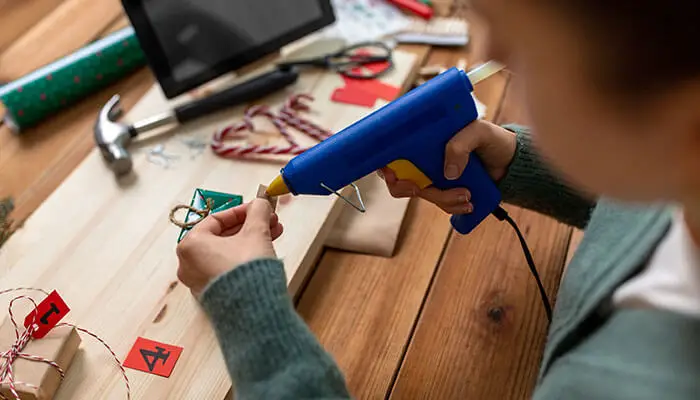
Although hot glue might work on some forms of faux leather, it’s not a great idea all around. Faux leather is usually made of plastic and other synthetic materials. Hot gluing these materials can cause them to melt or break down over time. This means that your patchwork project could be ruined after only a few days!
Additionally, using hot glue on faux leather can cause it to become stiff and brittle. This means that it won’t be able to move or flex in the same way as genuine leather does. On top of that, hot gluing faux leather can also lead to discoloration and a rough texture.[3]
How to Glue Leather to Leather?
If you’re looking to glue two pieces of leather together, hot glue can be a great option. Before getting started, make sure both surfaces are clean and dry so the adhesive will stick properly. Applying a bit of heat from a hairdryer can help soften up the leather and improve adhesion.
Once your pieces are ready, apply a small amount of hot glue to the area you’re working on. Use a cotton swab or other implements to spread the glue around evenly. If necessary, press down firmly for a few seconds until it adheres.
It’s important to work quickly with hot glue and leather since the adhesive can set quickly. Once your pieces are attached securely, it’s a good idea to add some weight or pressure on top them to ensure they stay in place until the glue dries fully.[3]
How to Glue Leather to Glass?
If you’re looking to glue leather to glass, it’s important to choose the right type of adhesive. Hot glue is not suitable for this type of application as it does not provide a secure bond and can be difficult to remove if it fails. Instead, use epoxy or contact cement for an effective and durable bond between the two materials.
When using epoxy, you’ll need to roughen up the glass surface with sandpaper or a wire brush for the best adhesive results. Once it’s ready, apply a generous amount of epoxy along the edges and press the leather down firmly. Allow the glue to cure completely before handling or use.[1]
How to Glue Leather to Plastic?
Glueing leather to plastic can be a tricky task. If you’re trying to attach leather to plastic, the best way is to use an adhesive specifically designed for the materials you are gluing together. There are several types of adhesives on the market that claim to work with both materials, but not all of them will provide a lasting bond.[1]
How to Glue Leather to Wood?
If you’re looking to glue leather to wood, hot glue is a great option. It offers an easy and effective way to adhere these two materials together. Here are the steps you should follow:
- Start by cleaning both surfaces – this will ensure that your adhesive bonds properly. Use a soft cloth moistened with water or mild detergent to wipe away any dust and dirt.
- Next, you’ll want to apply the glue. Place a generous amount of hot glue on one surface – either the leather or wood – and spread it evenly with your finger or a small tool like a popsicle stick. Make sure that the entire area is coated.
- Now, press the two materials together and hold them in place for one minute. Then, let the bond cool down before handling it.
- Lastly, use a damp cloth to clean off any excess glue that has squeezed out of the edges.[1]
How to Glue Leather to Metal?
Gluing leather to metal can seem like an intimidating task, but it doesn’t have to be. You may think that you need specialized tools or techniques in order to successfully glue the two materials together, but that isn’t necessarily true. Hot glue is actually a great option for gluing leather and metal together!
To adhere leather to metal with hot glue, start by ensuring that the surfaces of both the leather and metal are clean and free of dirt or debris. Then, heat up your hot glue gun as you would normally do. Once the gun is heated up and ready to use, apply a generous amount of hot glue to one surface (either the leather or the metal).[1]
FAQ
What is the best glue for leather?
When it comes to adhering leather, the best glue is a specialized adhesive that is designed specifically for bonding leather. This type of adhesive provides a strong bond between two surfaces and also has flexibility that will allow the bonded area to move without breaking apart. Examples of this type of adhesive include contact cement, polyurethane-based glue, hot melt glue.
Can you use any glue on leather?
No – not all glues are suitable for leather. For example, super glue is not suitable for bonding leather as it does not have the flexibility needed. In addition, some glues are too strong and can damage or discolor the leather over time.
What glue will stick to fake leather?
Hot glue is a great option for adhering fake leather. It provides an easy and fast way to bond materials together, as it melts at high temperatures and bonds quickly. However, it may not be the best option for more permanent fixes as it can become brittle with age. If you are looking for a more permanent solution, consider contact cement or polyureth.
How do you glue fake leather?
When gluing fake leather, it is important to use the correct adhesive. Hot glue is a great option for adhering materials together quickly and easily. It works by melting at high temperatures and bonding materials together equally as fast. To apply the hot glue, run a thin line of adhesive along the edge of one surface before pressing them together firmly. Allow the glued area to cool and set before separating the surfaces.
How do you fix leather with glue?
When fixing leather with glue, it is important to use the right adhesive for the job. While hot glue can be used for quick repairs, a more permanent solution would be contact cement or polyurethane-based glue. To apply the adhesive, simply run a thin line of glue along one surface before pressing them together firmly. Allow the glued area to set and dry thoroughly before separating the surfaces.
Useful Video: Does Fabric Glue Work on Leather? 2023
Conclusion
It is possible to use hot glue on leather, but it is not the recommended adhesive for this material. Hot glue can damage some types of leather and leave an unsightly residue that may be difficult to remove. It is best to opt for a stronger, longer-lasting adhesive like silicone or epoxy when working with leather. To ensure successful adhesion, clean the leather and use an adhesive that is compatible with it. Take your time when applying the glue and be sure to use a generous amount for maximum durability. With proper care and attention, you can achieve secure adhesion of leather projects with the right adhesive.
References
- ttps://theleathermakers.com/hot-glue-gun-and-leather/
- ttps://favoredleather.com/will-hot-glue-work-on-faux-leather/
- ttps://leatheradvice.com/how-to-glue-leather/

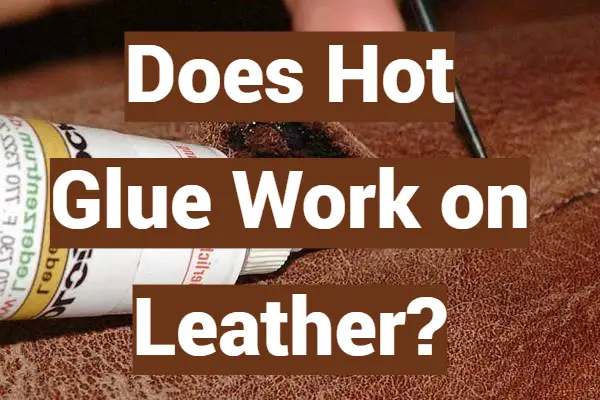
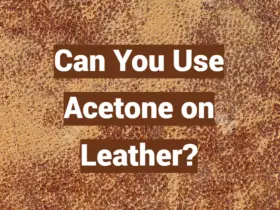

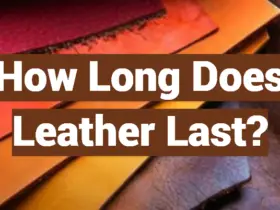


Leave a Reply